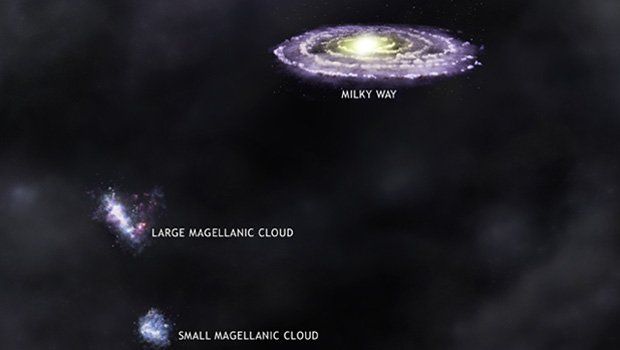Twin galaxies to Milky Way discovered

USING THE MOST-DETAILED map of the universe yet, researchers have discovered two groups of galaxies that resemble the Milky Way and its satellites, the Large- and Small Magellanic Clouds.
The finding reveals that although the Milky Way is a fairly typical spiral galaxy, its pairing with the Magellanic Clouds – two irregular dwarf galaxies that orbit it – is very rare indeed.
The discovery was made using data from the Galaxy and Mass Assembly (GAMA) survey, a project that uses the latest generation of ground-based telescopes, as well as space-borne survey facilities to study the local Universe.
3D map of the local Universe
“We’ve been building up a 3D map of the local Universe for five years now as part of the GAMA project,” lead researcher Dr Aaron Robotham told Australian Geographic. “This has involved dozens of astronomers spending a total of about 200 hundred nights at the Anglo-Australian Telescope, in NSW, observing about 200,000 spectra.”

GAMA202627, which is a similar galaxy to the Milky Way, has two companions off to the bottom and left of the image. (Credit: ICRAR/Aaron Robotham)
The astronomers studied these spectra – a breakdown of different wavelengths of light – to measure the distances between galaxies and their satellites.
“With this data, we are able to determine which large galaxies, such as our own, have companions that are close by,” says Aaron, who is based at both the University of Western Australia in Perth and the University of St Andrews in Scotland.
“Because we were looking for extremely rare systems, however, we had to survey a large chunk of the local Universe to make this discovery possible.”
The team – which reported its findings at the International Astronomical Union General Assembly in Beijing, China, last week – located 14 galaxy systems similar to the Milky Way-Magellanic Clouds pairing, but found only two that were an almost exact match.
“It’s only recently become possible to do this type of analysis that lets us find similar groups,” Aaron says. “In the data set used, 130,000 galaxies yielded only two good analogues to our own galaxy system.”
Distant systems of galaxies
The researchers plan to study the two galaxy systems further using data collected from the 8m Gemini telescope in Chile.
“The Anglo-Australian Telescope is one of the world’s most advanced, and most scientifically productive, facilities, and it made these observations possible,” Aaron says. “[But] deeper imaging data, taken on the Gemini [telescope], will reveal the fainter satellites that exist within these galaxy systems.”
Studying these galactic systems will help astronomers learn more about the Milky Way, comments Professor Joss Bland-Hawthorn a physicist involved in the GAMA survey at the University of Sydney.
“We want to understand our galaxy: where it came from and where it’s going… The discovery of only two other galaxy systems in the local Universe that are similar, demonstrates how unusual our galaxy is,” Joss says. “We live in a very special environment and by looking at these analogues we will be able to learn more about it.”
RELATED STORIES

